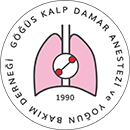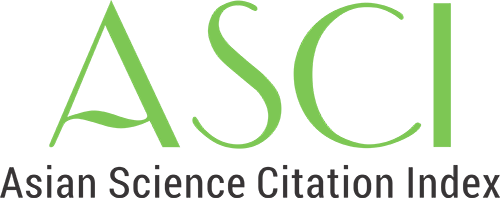

Volume: 20 Issue: 3 - 2014
| REVIEW | |
| 1. | Anesthesia in Cardiac Electrophysiology Laboratory Nihan Yapıcı doi: 10.5222/GKDAD.2014.135 Pages 135 - 140 (1432 accesses) Summary Electrophysiologic procedures in cardiac laboratoires have increased in frequency significantly since past decades. A large number of patients with complex co-existing disease are involving for procedures in the electrophysiology laboratory (EPL). The choice of anesthesia and particular anesthetics should be tailored to the procedure in those studies. It is better to choose a drug or a combination of drugs that do not interfere with the goals EP procedure. The aim of this article is revising our practice along with changing patient profile and developments in the field of cardiac electrophysiology and anesthesia. |
| RESEARCH ARTICLE | |
| 2. | Coagulation Effects of Hydroxyethylstarch Versus Modified Fluid Gelatin When Used as Normovolemic Hemodilution Solutions During Cardiac Surgery Tülün Öztürk, İsmet Topçu, Barış Tuncer, Barış Açıkgöz, Funda Yıldırım, İhsan İşkesen doi: 10.5222/GKDAD.2014.141 Pages 141 - 148 (1024 accesses) OBJECTIVE: The aim of this study to examine the effects of hydroxyethyl starch and gelatin solutions used for acute normovolemic hemodilution on coagulation during coronary artery bypass surgery. METHODS: Seventy-two patients undergoing elective coronary artery bypass graft surgery randomly received no hemodilution (control), or 6% HES 200/0.5 (n=24) or 4% gelatin solution (n=24) for acute normovolemic hemodilution before cardiopulmonary bypass. Thromboelastography parameters were measured before (T0) and after(T1) acute normovolemic hemodilution, and one(T2) and four(T3) hours after separation from CPB. RESULTS: The R (reaction) time in HES was significantly longer than in controls at T(2)(p=0.03). The K (coagulation) values in group HES and GEL were significantly longer than in controls at T(2) and T(3) (p=0.02 and 0.03,respectively). Rapidity of clot formation (alpha angle) was significantly smaller in HES and GEL compared to controls (p=0.01 and p=0.02, respectively). Maximum amplitudes in HES and GEL were not significantly different than controls at T(2)(p=0.3 and 0.9, respectively). At T2, three patients in GEL (but none in HES) showed clotlysis at 30 min (p=0.1). GEL and HES received fewer units of erythrocyts compared to controls(p<0.001); however, use of fresh frozen plasma was not significantly different than in controls. Mediastinal blood loss was greater in group HES than in controls(p<0.05). CONCLUSION: Performing acute normovolemic hemodilution with HES and GEL solutions caused significant change in coagulation state by thromboelastography, reduced the need for errytrocyt. Regarding the increase in mediastinal chest drainage, we concluded that HES may not be safety in patients undergoing coronary surgery. |
| 3. | Comparison Of The Efficacy Of Fiberoptic Bronchoscopy And Wireless Video Endoscope (Disposkope®) In Confirmation Of The Position Of Double Lumen Endotracheal Tube Hasan Mehmet Kamburoğlu, Gökhan Özkan, Tarık Purtuloğlu, Abdülkadir Atım, Memduh Yetim, Mehmet Emin İnce, Vedat Yıldırım, Ercan Kurt doi: 10.5222/GKDAD.2014.149 Pages 149 - 153 (1451 accesses) OBJECTIVE: In thoracic surgery, the position of doublelumen endotraceal tube placed in order to provide one-lung ventilation can be confirmed by various methods. In this study, we aimed to compare the groups undergoing thoracic surgery with fiberoptic bronchoscope or wireless video endoscope in confirmation of the position of doublelumen endotraceal tube with regard to success and duration of visualisation and the time until the begining of surgery. METHODS: After ethical committe approval, forthy voluntary patients undergoing thoracic surgery with doublelumen endotraceal tube were included in to the study. After intubation, the location of the doublelumen endotraceal tubes were evaluated by conventional methods and were given the correct position. The patients were randomly divided in two groups as video endoscope (Group I, n=20) and fiberoptic bronchoscope (Group II, n=20) groups. Afterwards, duration of visualisation and the time until the begining of surgery were recorded in both groups. RESULTS: There wasnt statistically significant difference between two groups in confirmation of doublelumen endotraceal tubes position. Malposition of doublelumen endotraceal tube was detected and fixed in three patients (15%) of group I and in seven (35%) of group II. Visualisation times were 18 sec in group I and 131 sec in group II (p< 0.05); and the times until the begining of surgery were 468 sec in group I and 690 sec in group II (p< 0.05). CONCLUSION: As a result, itseen that both methods were effective in the confirmation of doublelumen endotraceal tubes position in thoracic surgery. Apart from that, in confirmation of doublelumen endotraceal tubes position and earlier administiration to surgery, we concluded that wireless video endoscope may have shorter evaluation time. |
| 4. | Retrospective Study of Perioperative Anaesthesia in the Management of Thymectomy in Cases with Myasthenia Gravis Bengü Durmuş, Fatma Nur Kaya, Suna Gören, Gülnihal Acay, Selda Özden, Sinem Şentürk doi: 10.5222/GKDAD.2014.154 Pages 154 - 161 (1778 accesses) OBJECTIVE: Myasthenia Gravis (MG) is an autoimmune disease in the neuromuscular junction. In our study, we intend to analyze retrospectively, the perioperative anaesthetic management of MG patients, who underwent thymectomy between September 1994 and January 2013. METHODS: After the approval of ethics committee, 33 cases of ASA I-III class, between 18-59 ages, diagnosed with MG, underwent thymectomy and with complete data were included in the study. The demographic data and disease-specific features of the cases, perioperative anesthesia and analgesia management and complications were recorded. RESULTS: According to Osserman classification 87.9% are determined class 1 and 2, and 12.1% as class 3. Leventhal score of 3 cases were calculated as ≥10. Balanced anesthesia was applied to 9.1% of the cases, whereas balanced anesthesia and thoracic epidural analgesia to 78.8%, total intravenous anesthesia and thoracic epidural analgesia to 12.1%. Atracurium was the most preferable neuromuscular blocker in the induction with 15.2%. Fentanyl was preferred (60.6%) in 20 cases and alfentanil (39.4%) in 12 cases. In 2 cases neuromuscular blocker was used for maintenance and sugammadex was administered at the end of the surgery. All patients were extubated in the operating room. 14 of them were observed in the postoperative intensive care unit in the 1st day. Reintubation or ventilation support was not required. CONCLUSION: In conclusion, although there is not a standard protocol for the anesthetic management of MG cases, patient and drug interaction must be taken into consideration and the importance of effective analgesia and neuromuscular monitoring must be noted. |
| REVIEW | |
| 5. | Preoperative Assessment in the Elderly Patients Undergoing Cardiac Surgery Türkan Kudsioğlu doi: 10.5222/GKDAD.2014.162 Pages 162 - 166 (1704 accesses) In recent years, progress in living conditions and medicine has increased the number of people over 65 years of age. Thus, geriatric population is increasing among the patients undergoing cardiac surgery. The aging process leads to change in organ functions and chronic diseases. The elderly patients have more the ratio of morbidity and mortality than young patients. In elderly patients undergoing cardiac surgery, the success rations will increase when they are evaluated with the risk scores preoperatively and performed convenient anesthesia, surgery technics and carefully intensive care in elective operations, |
| CASE REPORT | |
| 6. | Anasthetic Management Of Patient With Parkinsons Disease Undergoing Mitral Valve Replacement Surgery - Enteral L-Dopa Administration: A Case Report Mehmet Burak Eşkin, Mehmet Emin İnce, Gökhan Özkan, Vedat Yıldırım, Ercan Kurt doi: 10.5222/GKDAD.2014.167 Pages 167 - 171 (1375 accesses) Parkinson disease is a neurodegenerative disorder common in the elderly. Although these patients have been operated several times, few case reports are available regarding optimal anesthetic management of patients with Parkinson's disease. Discontinuation of anti-parkinsonian drugs used before surgery and effects of using anesthetic agents often increase severity of disease, morbidity and mortality. We aimed to present the anesthetic management of mitral valve replacement surgery for 79-year-old patient with Parkinson disease who has been medicated for 10 years. Anti-parkinson drugs were given enterally during the perioperative period. The current literatures were reviewed and appropriate anesthesia management was achieved, the patient was discharged on the seventh postoperative day without any problem. |
| 7. | Anesthetic Management of Vena Cava Superior Syndrome Due to Mediastinal Mass Ahmet Selim Özkan, Muharrem Uçar, Mehmet Ali Erdoğan, Ökkeş Hakan Miniksar, Mahmut Durmuş doi: 10.5222/GKDAD.2014.172 Pages 172 - 174 (1256 accesses) Superior Vena Cava Syndrome (SVCS) is a clinical condition that causing edema the upper extremities and neck by decreased blood flow returning to the heart, due to compression which created mediastinal mass the surrounding structures. The anesthetic management of patients with Vkss must be careful due to life-threatening complications such as difficult airway management and cardiovascular collapse. In this case report, we aimed to present the anesthetic management of SVCS in patient scheduled for biopsy of mediastinal. |
| 8. | Pinch-Off Syndrome Presenting with Severe Arrhythmia Erkan Kaya, Gökhan Özkan, Mehmet Emin İnce, Mehmet Burak Eşkin, Kubilay Karabacak, Uygar Çağdaş Yüksel, Suat Doğancı, Vedat Yıldırım doi: 10.5222/GKDAD.2014.175 Pages 175 - 178 (1350 accesses) Totally implantable vascular catheters are used widely in patients who need long-term drug administration, parenteral nutrition and transfusion, because they allow safe and easily available vascular access. Pinch-off syndrome (POS) is described as breaking off the subclavian central venous catheter because of the compression by the surrounding tissues, first costa and clavicle. Embolization of deteached catheter part into ventricular space can cause serious arrhythmias. Today, with the help of advanced catheters used in the field of interventional radiology and cardiology, deteached catheter part which caused embolism is successfully removed percutaneously, and no additional surgical procedure is required. In this case report, we present a case of POS included serious arrhythmias because of fragmented catheter part moving into the heart and percutaneous treatment approach. |
| 9. | Anaphylactic Shock in Caesarean Section Mukadder Şanlı, Nurçin Gülhaş, Feray Akgül Erdil, Hakan Miniksar, Duygu Demiröz, Mahmut Durmuş doi: 10.5222/GKDAD.2014.179 Pages 179 - 182 (1147 accesses) Following contact with the allergen, allergic reactions ranging from the urticaria to anaphylaxis can be seen. The incidence of anaphylactic reactions in patients with asthma and allergic rhinitis are in higher rates in general population. Perianaesthetic anaphylaxis are important. It may be severe and potentially associated with adverse outcomes unless urgently recognized and treated. Anaphylaxis has been reported at the literature, with commonly used substances like latex, antibiotics, ranitidine, colloid solutions. Development of anaphylactic shock due to use of oxytocin is a rare side effect. We aimed to precented with this case the anesthetic management of anaphylactic shock in a pregnant women, without a history of allergic reaction, developed immediately after infusion of the oxytocin during cesarean section. |
| 10. | Our Experience of Veno-Venous ECMO treatment in Acute Respiratory Distress Syndrome Ahmet Şen, Başar Erdivanlı, Hızır Kazdal, Abdullah Özdemir, Şahin Bozok, Şeref Küçüker doi: 10.5222/GKDAD.2014.183 Pages 183 - 186 (1343 accesses) Acute respiratory distress syndrome is a multifactorial and serious disorder with a high mortality in all age groups. With the advances in extracorporeal membraneous oxygenators, tretament involving oxygenation through a membrane and lung protective mechanical ventilation is becoming widespread. We present management of acute respiratory distress syndrome due to serious thoracic injury following fall from height. The patient received ECMO treatment due to persistent hypoxia for nine days, and hypoxia resolved. Following a period of healing for one month, the tracheotomized patient was externed to the surgical ward. |
| LETTER TO THE EDITOR | |
| 11. | The Usage of Endobronchial Blocker in a Patient with Partial Laryngectomy for Single Lung Ventilation Ceren Aygün, Elvan Öçmen, Volkan Hancı, Semih Küçükgüçlü doi: 10.5222/GKDAD.2014.187 Pages 187 - 188 (939 accesses) Abstract | |

















